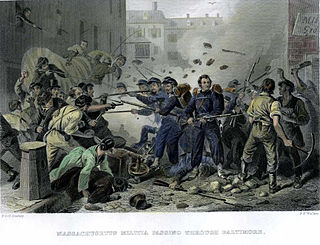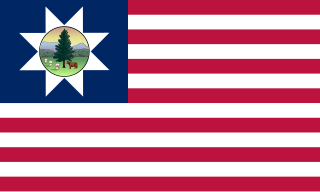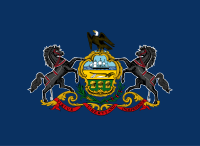Service
This regiment was organized at Philadelphia and mustered into federal service on May 1, 1861. This regiment was also a Philadelphia militia regiment and was recruited in that city. It was known as the Philadelphia Light Guard.
After mustering in, it went into camp near Philadelphia. In May the regiment was ordered to Baltimore and encamped at Locust Point. Later, it moved to Patterson's park and at Mount Clare. It performed guard and police duty in Baltimore until mustered out on August 7, at Philadelphia.
List of battles
The regiment participated in no battles during its service.
Detailed service
- Left Philadelphia for Baltimore, MD., May 17
- Duty near Fort McHenry, Locust Point, Patterson's Park and Mt. Clair till August
- Mustered out in Philadelphia, August 7, 1861

The Baltimore riot of 1861 was a civil conflict on Friday, April 19, 1861, on Pratt Street, Baltimore, Maryland. It occurred between antiwar "Copperhead" Democrats and other Confederate sympathizers on one side, and on the other, members of Massachusetts and Pennsylvania state militia regiments en route to the national capital at Washington who had been called up for federal service. The fighting began at the President Street Station, spreading throughout President Street and subsequently to Howard Street, where it ended at the Camden Street Station. The riot produced the first deaths of Union volunteers by hostile action, although caused by civilians, in the American Civil War. Civilians among the attackers also were killed.

George Cadwalader was a general in the United States Army during the Mexican–American War and American Civil War.

The 1st Vermont Infantry Regiment was a three months' infantry regiment in the Union Army during the American Civil War. It served in the eastern theater, in and around Fortress Monroe, Virginia.

The 7th Regiment of the New York Militia, aka the "Silk Stocking" regiment, was an infantry regiment in the Union Army during the American Civil War. Also known as the "Blue-Bloods" due to the disproportionate number of its members who were part of New York City's social elite, the 7th Militia was a pre-war New York Militia unit that was mustered into federal service for the Civil War.

The 9th New York Infantry Regiment was an infantry regiment that served in the Union Army during the American Civil War. It was also known as the "Hawkins' Zouaves" or the "New York Zouaves."

The 2nd Regiment Massachusetts Volunteer Infantry was an infantry regiment in the Union Army during the American Civil War. Major George H. Gordon, a West Point graduate and veteran of the Mexican–American War, organized the unit's recruitment and formation. The 2nd Massachusetts was trained at Camp Andrew in West Roxbury, Massachusetts on the site of the former Transcendentalist utopian community, Brook Farm. Roughly half the regiment was mustered in on May 18, 1861 and the remainder on May 25, 1861 for a term of three years. The regiment saw extensive combat as part of the Army of the Potomac particularly during the Battle of Antietam and the Battle of Gettysburg.
Turner Gustavus Morehead (1814–1892) was an officer in the Mexican–American War and American Civil War and Brevet Brigadier General in the Union Army.

The 4th Pennsylvania Infantry Regiment, officially known as the 4th Regiment, Pennsylvania Volunteer Infantry, was an infantry regiment of the Union Army in the American Civil War. Formed mostly from a militia unit in Norristown in southeastern Pennsylvania, the regiment enlisted at the beginning of the American Civil War in April 1861 for a three-month period of service under the command of Colonel John F. Hartranft. Logistical difficulties bedeviled the regiment, which served as part of the garrison of Washington, D.C., until late June, when it was sent into Northern Virginia to join in the army of Brigadier General Irvin McDowell.

The 5th Regiment Massachusetts Volunteer Militia was a peacetime infantry regiment that was activated for federal service in the Union army for three separate tours during the American Civil War. In the years immediately preceding the war and during its first term of service, the regiment consisted primarily of companies from Essex County as well as Boston and Charlestown.

The 6th Regiment Massachusetts Volunteer Militia was a peacetime infantry regiment that was activated for federal service in the Union army for three separate terms during the American Civil War (1861-1865). The regiment gained notoriety as the first unit in the Union Army to suffer fatal casualties in action during the Civil War in the Baltimore Riot and the first militia unit to arrive in Washington D.C., in response to President Abraham Lincoln's initial call for 75,000 troops. Private Luther C. Ladd of the 6th Massachusetts is often referred to as the first Union soldier killed in action during the war.

The 12th Regiment Pennsylvania Volunteer Infantry was an infantry regiment of the Union Army in the American Civil War. Raised in Pittsburgh and its surrounding counties in April 1861 for three months of service, the regiment spent its first month in training, then guarded the Northern Central Railway in Maryland until it was mustered out. Many of its men went on to serve in subsequent Pennsylvania regiments during the war.

The 196th Regiment Pennsylvania Volunteer Infantry, alternately the 5th Union League Regiment was an infantry regiment of the Union Army in the American Civil War. Raised in Philadelphia in mid-1864, the regiment was made up of Hundred Days Men in an effort to augment existing manpower for an all-out push to end the war within 100 days, and spent most of its service guarding Confederate prisoners of war at Camp Douglas.

The 197th Regiment Pennsylvania Volunteer Infantry, alternately the 3rd Coal Exchange Regiment was an infantry regiment of the Union Army in the American Civil War. Raised in Philadelphia in mid-1864, the regiment was made up of Hundred Days Men in an effort to augment existing manpower for an all-out push to end the war within 100 days, and spent most of its service guarding Confederate prisoners of war at Rock Island.

The 3rd Battalion Massachusetts Rifles was an infantry unit created at the start of the American Civil War and activated for federal service in the Union army for a term of ninety days. It consisted of three companies of prewar militia and one newly recruited company together organized under the command of Major Charles Devens. The term "rifles" was a designation frequently given to antebellum militia companies which trained in the use of rifled muskets—a relatively new innovation at the time—as opposed to smoothbore muskets. Only minor differences in training and tactics differentiated such units from a typical infantry company of the time. During the 1840s, "rifle" companies were often expected to train and serve as skirmishers in open order, however by the Civil War, United States army tactics manuals made no distinction between a company of "rifles" and a typical infantry company.

The 4th Regiment Massachusetts Volunteer Militia, sometimes known as the 4th Massachusetts Infantry, was a peacetime regiment of infantry that was activated for federal service in the Union Army for two separate tours during the American Civil War. Most of the companies were from Norfolk County, Massachusetts. The regiment had its headquarters in Quincy, Massachusetts.

The 172nd Pennsylvania Infantry was an infantry regiment in the Union Army during the American Civil War.

The 5th New York State Militia was a New York State militia, organized in 1861 in New York City, under Colonel C. Schwarzwaelder, Lieutenant Colonel Louis Burger and Major George Van Amsberg. The regiment's primary language was German. It offered its services to the state on 16 April 1861. Although the regiment was originally organized as artillery, it was assigned to the infantry.

The 24th Pennsylvania Volunteer Infantry was a three-month infantry regiment that served in the Union Army during the American Civil War.

The 21st Pennsylvania Volunteer Infantry was a three-month infantry regiment that served in the Union Army during the American Civil War.

The 19th Pennsylvania Volunteer Infantry was a three-month infantry regiment that served in the Union Army during the American Civil War.













